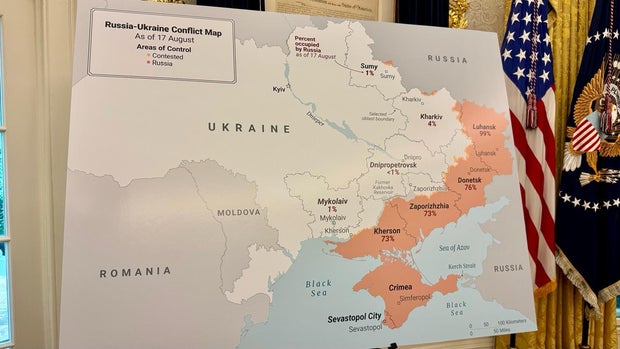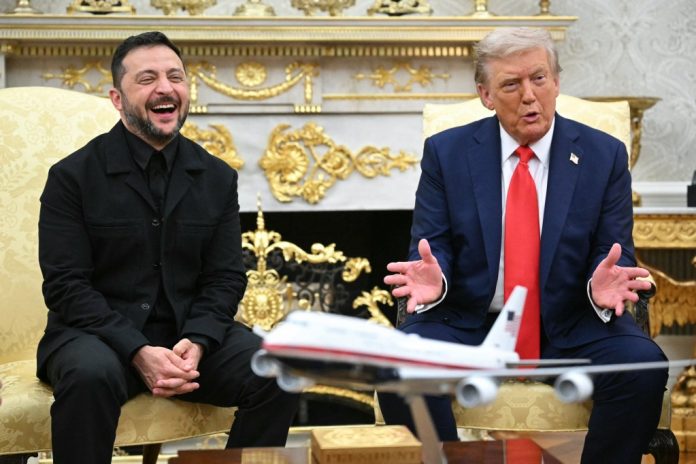Ukrainian President Volodymyr Zelensky and seven European leaders met with Donald Trump in Washington to discuss US involvement in security guarantees for Ukraine on Monday.
Zelensky’s European “bodyguards”
Seven European leaders accompanied Zelensky to Washington: British Prime Minister Keir Starmer, Italian Prime Minister Giorgia Meloni, German Chancellor Friedrich Merz, Finnish President Alexander Stubb, French President Emmanuel Macron, NATO Secretary General Mark Rutte and European Commission President Ursula von der Leyen. As The New York Times reported they feared that this time the dialogue between Trump and Zelensky would escalate into a public row, as happened in February.
The US president summed up the results of his meetings with Zelensky and European leaders, which he called “very good,” on Truth Social.
“New map” of Ukraine
In the Oval Office, before the closed part of the talks between Zelensky and Trump, a huge map of the hostilities was unfolded.

The map was placed opposite the presidential table. The map shows the territory of Ukraine, as well as the territories of the DPR (Donetsk region), LPR (Luhansk region), Crimea, Kherson and Zaporizhzhia regions, which were annexed by Russia following referendums.
“I showed the president a lot of details on the battlefield, on the map. Thank you very much. By the way, thank you for the map,” the Ukrainian leader said.
Trump’s aide Dan Scavino also posted a photo on social media with a map of Ukraine, with Trump and Zelensky standing next to it, and captioned it: “Before heading over to the Multilateral Meeting with European Leaders in the East Room of the White House.”
Ukrainian media reported that the map was brought by the Ukrainian delegation.
Kyiv ready for talks, Zelensky says
At a briefing after talks with Trump at the White House, Zelensky said that his country was ready for a meeting with Russia at the highest level without preconditions.
Kyiv had previously insisted that a ceasefire must first be achieved before negotiations could begin. “If Ukraine starts setting conditions for the meeting, some global ones, which are certainly fair….then the Russians will come up with a hundred conditions of their own,” the Ukrainian president said. It is necessary to hold a meeting and discuss ways to end the conflict, Zelensky also added.
Making a call to Russia
After talking with Ukrainian and European leaders, Trump called Russian President Vladimir Putin and informed him of the start of preparations for the meeting between Putin and Zelensky.
The Russian version of the 40-minute telephone conversation between Putin and Trump was presented by presidential aide Yuri Ushakov. The US president informed his counterpart about the talks with Zelensky and European leaders; during the conversation, Putin and Trump expressed support for direct talks between Russian and Ukrainian delegations (referring to the meetings that have been taking place in Istanbul since May), the presidential aide said.
“In this regard, in particular, the idea was discussed that it would be advisable to explore the possibility of raising the level of representatives of the Ukrainian and Russian sides. That is, those representatives who are participating in the aforementioned direct talks,” Ushakov said, without specifying whether this meant raising the level to that of presidents.
Possible concessions
The position of the US was outlined by Donald Trump, Secretary of State Marco Rubio and Trump’s special envoy Steve Witkoff in interviews and statements on August 17-18. It boils down to the following points:
- The return of Crimea to Ukraine and its accession to NATO are out of the question;
- Washington is ready to discuss security guarantees for Ukraine similar to Article 5 of the Washington Treaty on NATO (an attack on one is considered an attack on all);
- The US will not impose new sanctions against Russia; doing so would mean that the negotiations have failed;
- Although the US has long insisted on a ceasefire, it understands that a truce could quickly collapse, so its priority and ultimate goal is a “workable, verifiable, long-term” settlement agreement.
- According to Washington, Russia agreed at the Anchorage summit to make concessions on five regions (Moscow has not commented on this information), but without Ukraine, the issue of territories cannot be discussed.
What Zelensky and the Europeans achieved from Trump
Earlier, European leaders met with Zelensky in Washington to coordinate their positions ahead of the talks with Trump.
According to the Office of the President of Ukraine, the leaders welcomed the US decision to participate in security guarantees for Ukraine, based on this, one of the key issues is “the joint participation of the US and Europe in creating a future security architecture for Ukraine, and therefore for the entire European continent.”
European leaders have coordinated their positions repeatedly in recent days. In particular, on August 17, following a meeting of the “coalition of the willing,” they welcomed the decision of the US administration to join the security guarantees, in which the coalition, with its multinational forces, is ready to play a leading role.
No peacekeepers to Ukraine
French President Emmanuel Macron has stated the need for European military participation in future peacekeeping missions in Ukraine and assistance with ground operations. According to the French leader, this will be part of efforts to ensure stability after the end of hostilities.
Macron also said that the US president is ready to consider imposing secondary sanctions and tariffs against Moscow if Russia does not show willingness to negotiate.
Italian Prime Minister Giorgia Meloni has spoken out against French President Emmanuel Macron’s idea of sending a European peacekeeping contingent to Ukraine, Corriere della Sera reports.
Contrary to the French leader’s proposals, the head of the Italian government insists on extending the fifth article of the NATO charter to Ukraine. The provision would guarantee the country automatic protection by Alliance members in the event of an attack.
“Russia has 1.3 million soldiers: how many should we send to accomplish the task? If one of our soldiers dies, will we pretend nothing happened, or should we respond? Because if we respond, NATO will obviously have to act. And then we can immediately apply this provision,” Meloni replied to Macron’s proposal.
Voice from Europe
French politicians have criticised their colleagues who visited Washington on Monday.
Jean-Luc Mélenchon, leader of France Unbowed (LFI), wrote on X:
“At Trump’s feet, little Europeans come to hear the news. They are incapable of showing the unity needed to tell their master to stop the massacre in Gaza. And they are incapable of defending the mutual security of Europeans vis-à-vis Russia: nuclear power plants, a ban on medium-range missiles, etc. And vis-à-vis Ukrainians: free presidential and parliamentary elections, the restoration of trade unions and opposition parties. Good-for-nothings!”
Nicolas Dupont-Aignan, leader of the party Debout la France (France Arise), noted on X:
“International relations are not a game or a theatre stage: what happens in them is serious and sometimes tragic. Human lives are at stake. Great nations know this. They are guided by the principle of reality: the balance of power, strength, collective security, sovereignty. The much-vaunted freedom can only be achieved when people are masters of their own destiny, strong, respected and heard. This was once the case in France. Today, it seems that this is no longer the case. Destroyed, we see who we really are.”
